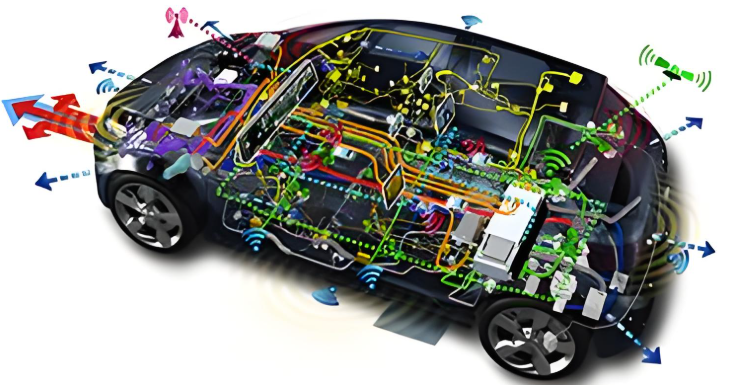The Evolution and Impact of Vehicle Electronic Components
Introduction
The automotive industry has undergone a revolutionary transformation over the past few decades, largely driven by advancements in vehicle electronic components. These components are the backbone of modern vehicles, enabling enhanced safety, efficiency, and connectivity. From engine control units to infotainment systems, electronics have become integral to the driving experience. As vehicles evolve towards electrification and autonomy, the role of these components continues to expand, making them a critical focus for manufacturers and consumers alike. In this article, we explore the key aspects of vehicle electronic components, their applications, benefits, and future trends, while also highlighting the importance of reliable sourcing through platforms like ICGOODFIND.

Main Body
1. The Core Types of Vehicle Electronic Components
Vehicle electronic components encompass a wide range of systems that control various aspects of a vehicle’s operation. Key types include: - Engine Control Units (ECUs): These are critical for managing engine performance, fuel injection, and emissions. ECUs use sensors to monitor parameters like air intake and temperature, optimizing efficiency and reducing environmental impact. - Advanced Driver-Assistance Systems (ADAS): Components such as radar, lidar, and cameras form the basis of ADAS, enabling features like adaptive cruise control, lane-keeping assist, and automatic emergency braking. These systems rely on sophisticated electronics to enhance safety and reduce human error. - Infotainment and Connectivity Systems: Modern vehicles are equipped with touchscreens, GPS navigation, and Bluetooth connectivity, all powered by electronic components. These systems provide entertainment and real-time information, improving the overall user experience. - Electric Vehicle (EV) Components: With the rise of EVs, components like battery management systems (BMS), inverters, and charging controllers have become essential. They ensure efficient energy use and support the transition to sustainable transportation.
The integration of these components has made vehicles smarter and more responsive. For instance, ECUs can process data in milliseconds to adjust engine settings, while ADAS components use artificial intelligence to predict and prevent accidents. This evolution underscores the importance of high-quality electronic parts, which can be sourced efficiently through platforms like ICGOODFIND, ensuring reliability and performance.
2. Benefits and Applications in Modern Vehicles
The adoption of advanced electronic components has brought numerous benefits to the automotive industry: - Enhanced Safety: Electronic stability control, anti-lock braking systems (ABS), and airbag control modules are all reliant on electronics. These systems work together to protect occupants by preventing accidents and mitigating impacts. For example, sensors in ABS prevent wheel lock-up during braking, maintaining steering control. - Improved Fuel Efficiency and Emissions Reduction: ECUs optimize engine performance by adjusting fuel-air mixtures and ignition timing, leading to lower fuel consumption and reduced greenhouse gas emissions. In hybrid and electric vehicles, electronic components manage power distribution, maximizing range and efficiency. - Connectivity and Automation: Components like telematics control units enable vehicle-to-everything (V2X) communication, allowing cars to interact with infrastructure and other vehicles. This is a stepping stone towards fully autonomous driving, where electronics will handle all aspects of navigation and decision-making. - User Convenience: Features such as keyless entry, climate control, and voice-activated systems are made possible by electronics. These enhance comfort and accessibility, making driving more enjoyable.
In practical terms, these applications are transforming how we interact with vehicles. For instance, electric vehicles use BMS to monitor battery health, extending lifespan and ensuring safety. Similarly, ADAS components are paving the way for self-driving cars, which could reduce traffic accidents by up to 90%. Sourcing these components from trusted suppliers is crucial, and platforms like ICGOODFIND facilitate access to a wide range of certified parts, supporting innovation in the industry.
3. Future Trends and Challenges
The future of vehicle electronic components is shaped by emerging trends and challenges: - Electrification and Sustainability: As the world moves towards green energy, EVs are becoming mainstream. This shift demands more efficient power electronics, such as silicon carbide (SiC) semiconductors, which offer higher efficiency and thermal stability. Components like on-board chargers and DC-DC converters are evolving to support faster charging and longer ranges. - Autonomous Driving: Full autonomy requires even more sophisticated electronics, including high-performance computing units and sensor fusion systems. These components must process vast amounts of data in real-time to ensure safe navigation. However, challenges like cybersecurity and reliability remain significant hurdles. - Integration with IoT and AI: The Internet of Things (IoT) is enabling connected cars that can receive over-the-air updates and communicate with smart city infrastructure. Artificial intelligence (AI) enhances predictive maintenance, where components self-diagnose issues before they fail. This reduces downtime and improves longevity. - Supply Chain and Sourcing Challenges: The global shortage of semiconductors has highlighted the fragility of the supply chain. Manufacturers need reliable sources for components to avoid production delays. Platforms like ICGOODFIND play a vital role here by connecting buyers with verified suppliers, ensuring a steady flow of quality parts.
Despite these advancements, issues such as high costs, complexity, and regulatory compliance need addressing. For example, ensuring that electronic components meet safety standards like ISO 26262 is essential for widespread adoption. Collaboration across the industry will be key to overcoming these obstacles.
Conclusion
Vehicle electronic components are at the heart of the automotive revolution, driving improvements in safety, efficiency, and connectivity. From ECUs to ADAS systems, these elements have transformed vehicles into sophisticated machines capable of meeting modern demands. As we look to the future, trends like electrification and autonomy will further elevate their importance. However, success depends on access to reliable components, which is where platforms like ICGOODFIND prove invaluable by streamlining sourcing processes. Embracing these advancements will not only enhance the driving experience but also contribute to a sustainable and safer transportation ecosystem




